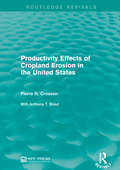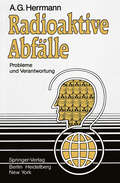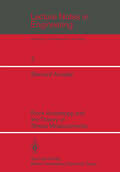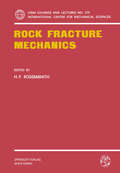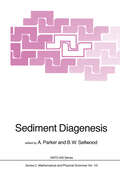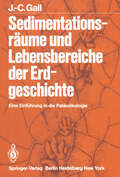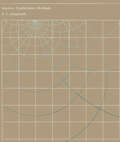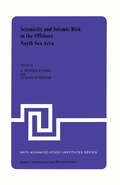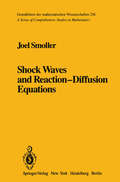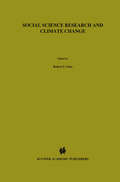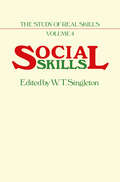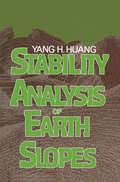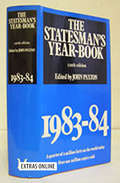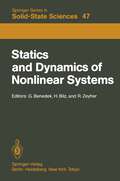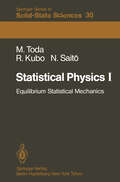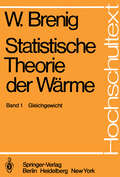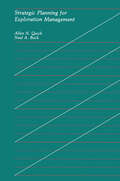- Table View
- List View
Probability, Statistical Optics, and Data Testing: A Problem Solving Approach (Springer Series in Information Sciences #10)
by B.R. FriedenA basic skill in probability is practically demanded nowadays in many bran ches of optics, especially in image science. On the other hand, there is no text presently available that develops probability, and its companion fields stochastic processes and statistics, from the optical perspective. [Short of a book, a chapter was recently written for this purpose; see B. R. Frieden (ed. ): The Computer in Optical Research, Topics in Applied Physics, Vol. 41 (Springer, Berlin, Heidelberg, New York 1980) Chap. 3] Most standard texts either use illustrative examples and problems from electrical engineering or from the life sciences. The present book is meant to remedy this situation, by teaching probability with the specific needs of the optical researcher in mind. Virtually all the illustrative examples and applications of the theory are from image science and other fields of optics. One might say that photons have replaced electrons in nearly all considera tions here. We hope, in this manner, to make the learning of probability a pleasant and absorbing experience for optical workers. Some of the remaining applications are from information theory, a con cept which complements image science in particular. As will be seen, there are numerous tie-ins between the two concepts. Students will be adequately prepared for the material in this book if they have had a course in calculus, and know the basics of matrix manipulation.
Productivity Effects of Cropland Erosion in the United States (Routledge Revivals)
by Pierre R. CrossonIn the 1970’s, agriculture in the United States seemed to be booming. With an extra demand for crops, extra acres were taken on to increase production which was predicted to increase further with an ever-growing population. However, concerns were beginning to be raised over the adequacy of land for crops as potential croplands began to be converted into urban areas as well as the effects of soil erosion decreasing the quality of these croplands. Originally published in 1983, this study investigates the threats to crop productivity in the U.S. with a focus on human-made problems. This title will be of interest to students of environmental studies.
Productivity Effects of Cropland Erosion in the United States (Routledge Revivals)
by Pierre R. CrossonIn the 1970’s, agriculture in the United States seemed to be booming. With an extra demand for crops, extra acres were taken on to increase production which was predicted to increase further with an ever-growing population. However, concerns were beginning to be raised over the adequacy of land for crops as potential croplands began to be converted into urban areas as well as the effects of soil erosion decreasing the quality of these croplands. Originally published in 1983, this study investigates the threats to crop productivity in the U.S. with a focus on human-made problems. This title will be of interest to students of environmental studies.
Quantum Theory of Magnetism: Magnetic Properties of Materials (Springer Series in Solid-State Sciences #32)
by Robert M. WhiteAlthough it is one of the oldest physical phenomena studied, magnetism con tinues to be an active and challenging subject. This is due to the fact that mag netic phenomena represent a complex application of quantum mechanics, statistical physics, and electromagnetism. As new magnetic materials are syn thesized and new experimental conditions realized, the very fundamentals of these subjects are expanded. Thus, the Kondo effect, like superconductivity, stimulated the development of many-body techniques; spin glasses with their competing interactions are leading to advances in statistical physics; and angle and spin-resolved photoemission is probing details of transition-metal electronic states never before possible. I have not tried to incorporate all the new developments in this subject since the first edition ten years ago. My purpose is still the same - to use linear response theory to establish a common conceptual basis for understanding a variety of magnetic phenomena. Many recent developments fit into this frame work and have been included.
Recent Advances in the Understanding of Solar Flares: Proceedings of the U.S.-Japan Seminar held at Komaba, Tokyo, 5–8 October 1982
by S. R. Kane Yutaka Uchida K. Tanaka Hugh S. HudsonThese Proceedings result from the papers and discussions of the U.S.-Japan Seminar "Recent Advances in the Understanding of Solar Flares" held in Tokyo October 5-8, 1982. The meeting was sponsored jointly by the Japan Society for the Promotion of Science and the u.S. National Science Foundation. The principal aim of the meeting was to obtain the most up-to-date physical picture of solar flares by bringing together results from the recent observations by the Solar Maximum Mission (SMM) and HINOTORI satellites, together with other satellite data and ground-based data at both optical and radio wavelengths. These data cover the recent maximum of the solar activity cycle. The SMM and HINOTORI introduced a new dimension in flare observations by carrying out the first hard X-ray imaging observations, and the organizers especially felt that an intense discussion of the significance of these results in the context of flare theories would be important. Starting with an introductory presentation of the characteristics of the instruments on board the satellites, the sessions of the first day and the beginning of the second dealt mainly with energy transport in flares and with .the formation process of the hot plasma which is .
Regional Trends in the Geology of the Appalachian-Caledonian-Hercynian-Mauritanide Orogen (Nato Science Series C: #116)
by P. E. SchenkThe classical Appalachian, Caledonian, Hercynian, and Mauritanide orogens are now only segments of a once-continuous Paleozoic mountain belt which has been fragmented during Mesozoic-Cenozoic formation of the North Atlantic Ocean. These segments are major parts of the countries surrounding the North Atlantic - most of which are members of NATO. The aim of this NATO conference was to evaluate these fragments in terms of their pre-Mesozoic positions, and to attempt a synthesis of their geologic evolution on an international and orogen-wide scale. Geologists who have studied these scattered remnants have been separated by both geography and discipline. Orogen-wide syntheses have beeen attempted in the past by individuals who are specialists not only in discipline but also in geography; therefore, these attempts have not been satisfactory to everyone. This conference brought together the foremost specialists in different disciplines from each country. They attempted to teach other specialists, not only in their own fields, but in other disciplines, about regional variations and particular problems. The resulting international cross-fertilization, both within and between speciaLties, enriched individual workers and helped to provide a multi-disciplinary overview of the orogen.
Remote Assessment of Ocean Color for Interpretation of Satellite Visible Imagery: A Review (Coastal and Estuarine Studies #4)
by H. R. Gordon A. Y. MorelSince the pioneering work of Clarke et a1. (1970) it has been known that chlorophyll a (or. more generally. pigments) contained in phytoplankton in near-surface waters produced systematic variations in the color of the ocean which could be observed from aircraft. As a direct result of this work. NASA developed the Coastal Zone Color Scanner (CZCS). which was launched on Nimbus-G (now Nimbus-7) in October 1978. (A short description of the CZCS is provided in Appendix I. ) Shortly before launch. at the IUCRM Colloquium on Passive Radiometry of the Ocean (June 1978). a working group on water color measurements was formed to assess water color remote sensing at that time. A report (Morel and Gordon. 1980) was prepared which summarized the state-of-the-art of the algorithms for atmospheric correction. and phytoplankton pigment and seston retrieval. and which included recommendations concerning the design of next generation sensors. The water color session of the COSPAR/SCOR/IUCRM Symposium 'Oceanography from Space' held in Venice (May 1980. i. e •• in the post-launch period) provided the opportunity for a reassessment of the state-of-the-art after having gained some experience in the analysis of the initial CZCS imagery. Such an assessment is the purpose of this review paper. which will begin with an outline of the basic physics of water color remote sensing and the fundamentals of atmospheric corrections. The present state of the constituent retrieval and atmospheric correction algorithms will then be critically assessed.
Remote Sensing Applications in Marine Science and Technology (Nato Science Series C: #106)
by A. P. CracknellThis summer school was a sequel to the summer school on Remote Sensing in Meteorology, Oceanography and Hydrology which was held in Dundee in 1980 and the proceedings of which were published by Ellis Horwood Ltd., Chichester, England. At the present summer scnool we concentrated on only part of the subject area that was covered in 1980. Although there was some repetit ion of material that was presented in 1980, because by and large we had a new set of participants, most subjects were treated in considerably greater detail than had been possible previously. The major topics covered in the present summer school were (i) the general principles of remote sensing with particular reference to marine applications, (ii) applications to physical oceanography, (iii) marine resources applications and (iv) coastal monitoring and protection. The material contained in this volume represents the written texts of most of the lectures presented at the summer school. One important set of lecture notes was not available; this was for the lectures on active microwave techniques, principally synthetic aperture radar, by W. Alpers from Hamburg. For this material we would refer the reader to "Imaging Ocean Surface Waves by Synthetic Aperture Radar - A Review" by W. Alpers,which is to appear as chapter 6 in "Satellite Microwave Remote Sensing" edited by T.D. Allan (Ellis Horwood, Chichester) which is to be published in 1983.
Rock Anisotropy and the Theory of Stress Measurements (Lecture Notes in Engineering #2)
by Bernard AmadeiAny undisturbed rock mass is subject to natural stresses inclu ding gravitational stresses due to the mass of the overburden and possibly tectonic stresses due to the straining of the earth's crust and remanent stresses due to past tectonism. Knowledge of the in situ stress field must be integrated into any rock engineering design along with general rock mass characteristics such as de for mability, strength, permeability and time dependent behavior. For example, the choice of optimum orientation and shape of deep underground caverns or complex underground works will be controlled by the orientation and the magnitude of the in situ stress @ield if it is necessary to minimize stress concentration problems. Long term variation of the in situ stress field may also help to evaluate the potential hazard of earthquake occurences. The magnitude and orientation of the stress field ata point within a rock mass can be measured but there is no known method by which the state of stress at a point can be accurately determined by instruments located remotely. In general, measurements are made inside boreholes, on outcrops or on the internal surfaces of under ground cavities. Most of the measuring techniques intentionally disturb the state of stress in the rock and then measure consequent strains and displacements. Measured strains or displacements are then related to the stresses through assumptions of material behavior. A common procedure is to assume that the rock mass is linearly elastic, isotropic, continuous and homogeneous.
Rock Fracture Mechanics (CISM International Centre for Mechanical Sciences #275)
by H. P. RossmanithScattering Theory for Many-Body Quantum Mechanical Systems: Rigorous Results (Lecture Notes in Mathematics #1011)
by I.M. SigalSediment Diagenesis (Nato Science Series C: #115)
by A. Parker B. W. SellwoodThe topic of sediment diagenesis is of fundamental importance to industry in the evaluation of hydrocarbon and water reservoir rocks. Detailed knowledge of the diagenetic textures, fabrics, and minerals, and a prediction of the regional diagenetic response, partly controls hydrocarbon recovery programmes. In other words, knowledge of the diagenesis can aid (or even control) conservation policy. Similarly, facies and diagenetic trends w.ithin basins can influence exploration policy. This volume incorporates the majority of the principal contributions given to the NATO Advanced Study Institute held in the University of Reading, U.K., from July 12th-25th, 1981, at which the major themes of carbonate and terrigenous clastic sediments were treated sequentially from deposition to deep burial. Eighty selected scientists from twelve NATO and three other countries participated in the Institute. The keynote addresses which acted as the touchstones for discussion are presented here in the expectation that they will stimulate a still wider audience. We gratefully acknowledge the award of a grant from the Scientific Affairs Division of NATO to run the Institute, and also the cooperation of the University of Reading. Mrs. D. M. Powell helped in many ways with the organisation, and also retyped the entire manuscript of this book. A. Parker B. lv. Sellwood vii FACIES, SEQUENCES AND SAND-BODIES OF THE PRINCIPAL CLASTIC DEPOSITIONAL ENVIRONMENTS T.Elliott Department of Geology University College of Swansea Singleton Park, Swansea SA 2 8PP Wales, U.K.
Sedimentationsräume und Lebensbereiche der Erdgeschichte: Eine Einführung in die Paläoökologie
by J.-C. GallSeismic Exploration Methods
by Ray L. SengbushThis book describes the seismic methods used in geophys ical exploration for oil and gas in a comprehensive, non rigorous, mathematical manner. I have used it and its predecessors as a manual for short courses in seismic methods, and it has been extensively revised time and again to include the latest advances in our truly remark able science. I once called it, "Advanced Seismic Inter pretation," but the geophysicists who attended the courses always wondered when I was going to start dis cussing interpretation. They discovered at the end that I never did discuss interpretation as they knew it. No men tion was made of reflection picking, posting times, map ping, contouring, and things they already knew perfectly well. Instead, I discussed Fourier transforms, sampling theory, impulse responses, distortion operators, Wiener filters, noise in f-k space, velocity spectra, wave-equation migration, and direct detection of hydrocarbons as each of these topics appeared on the seismic scene. I wanted the geophysicists to think beyond the routine ofinterpre tation, to develop a better understanding of why seismic sections look as they do, to have a better feel for what digital processing is doing, for good or evil, to the seismic data. I attempted to stretch their minds. Whitehead said it best: "A mind once stretched by a new idea can never shrink to its former dimension. " May this book be a suc cessful mind-stretcher. R. L.
Seismicity and Seismic Risk in the Offshore North Sea Area: Proceedings of the NATO Advanced Research Workshop, held at Utrecht, The Netherlands, June 1–4, 1982 (Nato Science Series C: #99)
by A. R. Ritsema A. GurpinarThe Workshop on the Seismicity and Seismic Risk in the Off shore North Sea Area was intended to bring together experts from a variety of disciplines as well as interest groups with involve ment in siting, design and construction of offshore structures in the region. Participants came from the fields of geology, seismology, oceanography, geotechnical and structural engineering and risk analysis. The wide range of participant affiliations included institutes, Observatories, universities, oil companies, consultants and insurance firms. All nationalities around the North Sea were present, in addition to some experts from outside the region. All participants were present on the basis of personal invitation. The idea of organizing the Workshop stemmed from conside- tions, such as: the rapidly increasing material and personel investments and versatility of type of structures in the basin.during the past decade; - the present-day important role Jf the North Sea oil and gas production in the economy of Western Europe; and - the increase of potential environmental risks in the region. Although devastating earthquakes are almost unknown in the area and seismic hazard is not great, the seismic risk grows with the growing size and number of structures in the area. The study of the potential seismic risks, therefore, cannot be neglected any more. The siting and design of offshore platforms and submarine pipelines are controlled by the degree of their vulnerability as well as the seismic hazard. in the region.
Shock Waves and Reaction—Diffusion Equations (Grundlehren der mathematischen Wissenschaften #258)
by Joel Smoller. . . the progress of physics will to a large extent depend on the progress of nonlinear mathe matics, of methods to solve nonlinear equations . . . and therefore we can learn by comparing different nonlinear problems. WERNER HEISENBERG I undertook to write this book for two reasons. First, I wanted to make easily available the basics of both the theory of hyperbolic conservation laws and the theory of systems of reaction-diffusion equations, including the generalized Morse theory as developed by C. Conley. These important subjects seem difficult to learn since the results are scattered throughout the research journals. 1 Second, I feel that there is a need to present the modern methods and ideas in these fields to a wider audience than just mathe maticians. Thus, the book has some rather sophisticated aspects to it, as well as certain textbook aspects. The latter serve to explain, somewhat, the reason that a book with the title Shock Waves and Reaction-Diffusion Equations has the first nine chapters devoted to linear partial differential equations. More precisely, I have found from my classroom experience that it is far easier to grasp the subtleties of nonlinear partial differential equations after one has an understanding of the basic notions in the linear theory. This book is divided into four main parts: linear theory, reaction diffusion equations, shock wave theory, and the Conley index, in that order. Thus, the text begins with a discussion of ill-posed problems.
Social Science Research and Climate Change: An Interdisciplinary Appraisal
by Stephen H. Schneider EliseBoulding Robert S. ChenSocial Skills
by W. T. Singletonw. T. SINGLETON THE CONCEPT This is the fourth in a series of books devoted to the study of real skills. A skilled person is one who achieves his objectives effectively, that is by an optimal expenditure of effort, attention and other resources working within his native capacities of strength, vision, intelligence, sensitivity and so forth. It is difficult if not impossible to measure in a quantitative sense. There is, however, no question about its presence or absence. The differences between a highly skilled performer and a mediocre one are so readily manifest that there is no ambiguity. The student of skill is a person interested in what these differences are and how they originate. The importance and the difficulty of skill study is that the concept is a universal one for human activity. The movement of one limb can be skilled or unskilled within the context of a task, so also can the way a leader addresses a large meeting of his followers. For these and other equally disparate activities there are certain descriptive terms which always seem to be applicable: continuity, sequencing, timing, together with a subtle combination of sensi tivity, adaptability and imperturbability. What happens at any instant is set precisely with the flow from what has already happened to what is going to happen. The order of events has a determinate logic which may not be obvious to the observer except with the benefit of hindsight.
Stability Analysis of Earth Slopes
by Y.H. HuangDuring the past several years I have been engaged in applied research related to the stability analysis of slopes. This research was supported by the Institute for Mining and Minerals Research, University of Kentucky, in response to the Surface Mining Control and Reclamation Act of 1977, which requires stability analysis for refuse dams, hollow fills, and spoil banks created by surface mining. The results of the research have been published in several journals and reports and also presented in a number of short courses. Both the sim plified and the computerized methods of stability analysis, as developed from this research, have been widely used by practicing engineers throughout Ken tucky for the application of mining permits. The large number of out-of-state participants in the short courses indicates that the methods developed have widespread applications. This book is a practical treatise on the stability analysis of earth slopes. Special emphasis is placed on the utility and application of stablity formulas, charts, and computer programs developed recently by the author for the analy sis of human-created slopes. These analyses can be used for the design of new slopes and the assessment of remedial measures on existing slopes. To make the book more complete as a treatise on slope stability analysis, other methods of stability analysis, in addition to those developed by the author, are briefly discussed. It is hoped that this book will be a useful reference, class room text, and users' manual for people interested in learning about stability analysis.
The Statesman's Year-Book 1983-84 (The Statesman's Yearbook)
by John PaxtonThe classic reference work that provides annually updated information on the countries of the world.
Statics and Dynamics of Nonlinear Systems: Proceedings of a Workshop at the Ettore Majorana Centre, Erice, Italy, 1–11 July, 1983 (Springer Series in Solid-State Sciences #47)
by Giorgio Benedek H. Bilz R. ZeyherThe investigation of the properties of nonlinear systems is one of the fast deve loping areas of physics. In condensed matter physics this 'terra incognita' is approached from various starting points such as phase transitions and renormali zation group theory, nonlinear models, statistical mechanics and others. The study of the mutual interrelations of these disciplines is important in developing uni fying methods and models towards a better understanding of nonlinear systems. The present book collects the lectures and seminars delivered at the workshop on "Statics and Dynamics of Nonlinear Systems" held at the Centre for SCientific Culture "Ettore Majorana·" in Erice;· Italy, July 1 to 11, 1983, in the framework of the International School of Materials Science and Technology. Experts and young researchers came together to discuss nonlinear phenomena in condensed matter physics. The book is divided into five parts, each part containing a few general artic les introducing the subject, followed by related specialized papers. The first part deals with basic properties of nonlinear systems including an introduction to the general theoretical methods. Contrfbutions to the nonlinear aspects of phase transitions are collected in the second part. In the third part properties of incommensurate systems are discussed. Here, competing interactions lead to charge-density waves, soliton lattices and other complex structures. Another point of special interest, illustrated in the fourth part, is the 'chaotic' be havior of various systems such as Josephson junctions and discrete lattices.
Statistical Physics I: Equilibrium Statistical Mechanics (Springer Series in Solid-State Sciences #30)
by M. Toda R. Kubo N. SaitoThis first volume of Statistical Physics is an introduction to the theories of equilibrium statistical mechanics, whereas the second volume (Springer Ser. Solid-State Sci., Vol. 31) is devoted to non equilibrium theories. Particular emphasis is placed on fundamental principles and basic con cepts and ideas. We start with physical examples of probability and kinetics, and then describe the general principles of statistical mechanics, with appli cations to quantum statistics, imperfect gases, electrolytes, and phase tran sitions, including critical phenomena. Finally, ergodic problems, the me chanical basis of statistical mechanics, are presented. The original text was written in Japanese as a volume of the Iwanami Series in Fundamental Physics, supervised by Professor H. Yukawa. The first edition was published in 1973 and the second in 1978. The English edition has been divided into two volumes at the request of the publisher, and the chapter on ergodic problems, which was at the end of the original book, is included here as Chapter 5. Chapters 1,2,3 and part of Chapter 4 were written by M. Toda, and Chapters 4 and 5 by N. Saito. More extensive references have been added for further reading, and some parts of the final chapters have been revised to bring the text up to date. It is a pleasure to express my gratitude to Professor P. Fulde for his detailed improvements in the manuscript, and to Dr. H. Lotsch of Springer Verlag for his continued cooperation.
Strategic Planning for Exploration Management
by Allen N. Quick Neal A. BuckIn all the industries in which I do management consulting, each manager considers his own industry to be truly "unique. " Of course, each is different in some respects, and each has its own quirks and features. However, the similarities among in dustries far outweigh the differences. The critical dynamics and the management issues have a great deal in common. However, there are, I believe, two industries (or segments of industries) that have an important critical uniqueness that does distinguish them from the rest. One of these is the exploration for undiscovered natural resources, notably for oil and gas; the other is research. In these two in dustry segments, the competition is not nearly so much one firm against another as it is each firm against "nature," or-if you prefer-against the unknown. This uniqueness not only sets these two industry segments apart from the rest, it also helps us to see what they have in common with each other: - Pure scientific talent, ability, and genius have direct commercial value. - We do not have the zero sum game of competition in the market place. A discovery by one firm does not usually perceptably lessen the opportunity of a "competitor" for a discovery. On the contrary, a discovery by one firm usually increases the knowledge of the whole industry, increasing com petitors' opportunity for discovery. - We see the source of continuing life for the rest of the firm.

